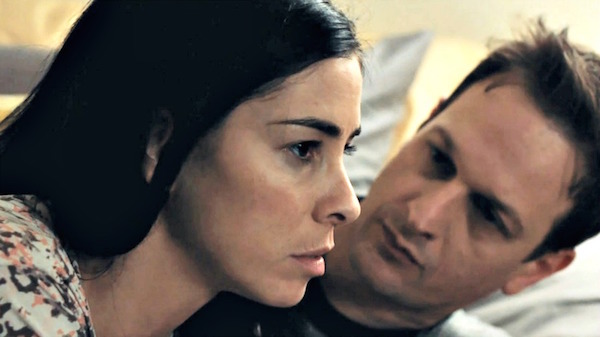– by Anne Brodie
Adam Salky’s searing film about a suburban wife and mother’s descent into drug addiction I Smile Back stars comedian Sarah Silverman. At first glance it seems an odd choice, but Salky wasn’t surprised when she turned in a stirring, authentic performance. And he explains how her character isn’t especially likeable and yet we become powerfully attached to her. WhatSheSaid spoke with Salky from California.
It’s tough for an audience to have a film’s focal character who is willfully self-destructive and selfish, not sympathetic.
The power was in Sarah Silverman’s performance and as an artist. I can’t take credit, I didn’t cast her. It was underway four years before I was attached to direct. But I believed she would be great. I believe there is a certain quality in Sara and as a person that gives the audience permission to go on this very complex and disturbing journey with this character.
How did you come to believe?
I read the screenplay and was profoundly moved by it. It tells a universal and tragic story and I was intrigued that Sarah was hoping to play Lainey. I had read Sarah’s book The Bedwetter: Stories of Courage, Redemption, and Pee and her struggle with drugs and pharmaceuticals. To me that’s the gold standard from a director’s standpoint. If you know your lead, your star has personal, relatable experience as a character then you know you’ll be able to work with to infuse that into their performance.
What did you bring her?
Sarah and I had a really great intense collaboration. When I look at her performance in the finished film I really see a combination of things she brought to Lainey and the things that I brought to her for discussion. A lot of it was about focusing Sarah’s tremendous sensitive dramatic insight and artistic insight into the character of Lainey. I love working with actors to get into the charcaters inner workings. We did it in advance during some rehearsal and every day onset. For a scene we’d speak in between each take. Those discussions were getting to the root of the scene.
You can see that she threw herself into it – is it hard as a director to watch an actor put herself through pain?
There is something interesting that happens when you make a movie like this that deals with personal material. You’re only there if the material is personal to you too. The reality is that in this film, the wonderful thing that happened is everyone even the production assistant had some kind of connection to the story as well. I interviewed these people for the jobs I didn’t pry but people offered. It was their mother, best friend or cousin and we had the sense that everyone was there to tell the truth about this woman and this story…. we were watching difficult things happen in front of our eyes but it never hurt anyone because
You do everything you can to make sure the actors feel as protected as you could make the. Simple things like having a robe right next to the camera at cut to keep them warm.
How much time and energy did you spend discussing the moments?
There was no time on this film, has to stand on its own and people will watch and feel drawn into Sarah’s fiction of Lainey. They will or they won’t but I do think there is something the director only cares about. There’s an extra element of amazement I feel when I watch the film because this movie was so hard. We had no time. It was shot in 20 days with half a million dollars. There was no time to have a scene not work. Sarah and Josh Charles and the crew were acutely aware of that so there was a feeling on everyone’s behalf of intense focus. We had to get in there and capture on film truthfully and efficiently. We went to battle. Everything you see in the movie was captured under the most restrictive production.
It dares to be still and quiet which gives it power.
I always strive to design a visual language and style for the film that is unique to everything I direct. I smile back was definitely a design element there really was a design element to keep the camera with Sarah Silverman as Lainey in every scene. There are lots of close-ups and idea of visual idea of keeping the camera with her as much as much as possible, she is in every scene in her experience. There is a particular moment of silence that was very important to me when she comes home from the conference to an empty house there is a series of shots of the empty rooms and the empty family table and without dialogue. Silence is a tool in cinema like any other.
The film is a woman’s story. Did you alter your approach at all?
I didn’t. There’s a lot of discussion about the lack of jobs for female filmmakers. To me that problem is we have to fix that problem. Ultimately I’m an optimist. I hope we get to deeper equality in film business and TV but when we do get there I don’t think the influx of female directors will have to direct films about women. When I read the screenplay I felt I knew her and the world and I didn’t stop to think wait the protagonist is a woman.
